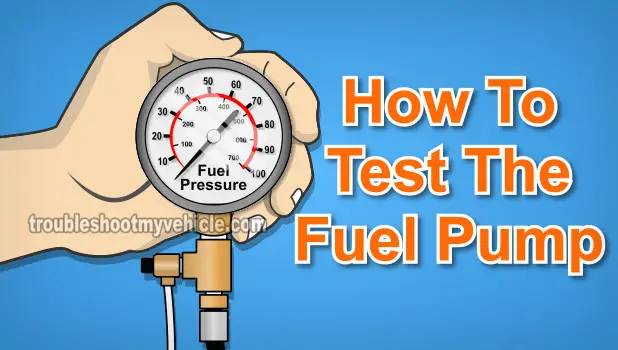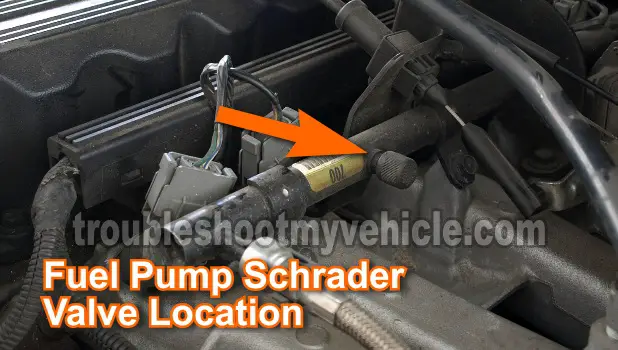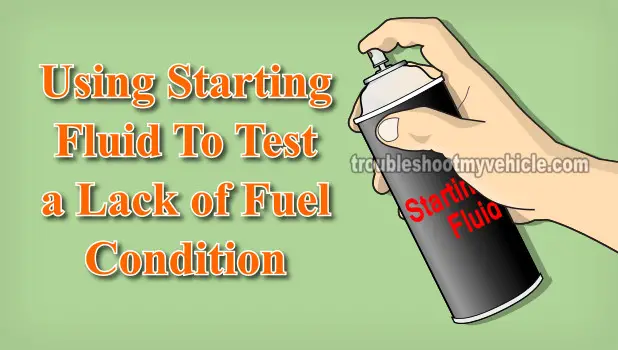
A bad fuel pump, that has stopped sending fuel to the fuel injectors, will cause a 'cranks but does not start condition' on your 4.0L equipped Jeep.
A fuel pump that is working, but not sending enough volume and therefore not producing enough fuel pressure, will cause severe drive-ability issues.
The cool thing is that it's easier than 'a hot knife cutting through butter' to test the fuel pump's pressure and/or check a lack of fuel condition causing a no-start condition.
In this tutorial, I'll show you the 2 basic tests you'll need to do to check the condition of your Jeep's fuel pump.
Contents of this tutorial:
ES ![]() You can find this tutorial in Spanish here: Cómo Probar La Bomba de Combustible (4.0L Jeep) (at: autotecnico-online.com).
You can find this tutorial in Spanish here: Cómo Probar La Bomba de Combustible (4.0L Jeep) (at: autotecnico-online.com).
Symptoms Of A Bad Fuel Pump
The fuel pump, in your 4.0L equipped Jeep, usually fails in one of two ways. It'll either stop pumping fuel or it will pump a volume that's lower than normal.
Obviously, when the fuel pump completely fails, your 4.0L Jeep isn't gonna' start. In this type of scenario you'll see that:
- The engine turns over but will not start.
- The ignition coil pack is creating and distributing spark to all 6 cylinders.
- The PCM will still pulse (activate) all 6 fuel injectors.
But when the fuel pump sends a lower than normal volume of fuel, your Jeep will start and run but with engine performance problems. You'll probably see one or more of the following symptoms:
- Rough idle.
- Engine starts after extended cranking.
- Lack of power when accelerating the vehicle down the road.
- Back-fires thru' the intake manifold when accelerating your Jeep down the road.
Both of these conditions can be tested with a fuel pressure gauge. Alright, with this info under our belts, let's get testing.
Where To Buy A Fuel Pressure Test Gauge
You can buy a fuel pressure test gauge just about anywhere and is one of the most important tools any serious DIY'er should have in his/her tool box.
The following fuel pressure test gauge kits are pretty good deals and include the adapter to tests all Jeep with a Jeep-type Schrader valve:
All of the fuel pump pressure test kits above have the fitting that will connect to your Jeep's Schrader valve.
TEST 1: Checking Fuel Pressure With A Fuel Pressure Gauge

The fuel pressure specification, from the Jeep repair manual, is 30 to 35 PSI. The only way this specification can be checked is by using a fuel pressure gauge.
Checking the fuel pump with a fuel pressure gauge is the most accurate and professional way of checking the state of the fuel pump (by the way, it's how it's done at any professional repair shop).
We can connect a fuel pressure gauge to the fuel system using the Schrader valve located on the fuel injector rail (see photo above).
NOTE: If you don't have a fuel pressure gauge, take a look at the section: Where To Buy A Fuel Pressure Test Gauge.
OK, let's get started with this test:
- 1
Place a shop towel around the Schrader valve. The shop towel's job is to absorb any fuel that may leak when doing step 2.
- 2
Connect the fuel pressure gauge to the Schrader valve on your 4.0L Jeep's fuel injector rail.
- 3
When ready, ask your helper to cycle the key on and off but don't crank the engine while you observe the fuel pressure tester's gauge.
Check the connection at the Schrader valve for fuel leaks and if any tighten the fuel pressure a bit more (by hand only) to eliminate them. - 4
Your fuel pressure gauge should register: 30 to 45 PSI with the Key On Engine Off (KOEO) if the fuel pump is OK.
Let's take a look at what your results mean:
CASE 1: If the fuel pressure gauge registered 0 PSI. This confirms that the cause of your 4.0L engine's no-start problem is caused by a lack of fuel.
Now, I usually take one more precaution, before condemning the fuel pump as bad and this is to check that the fuel pump is getting 12 Volts as the engine is cranking. This is just to make sure that the fuel pump relay and fuse are OK and doing their job.
What you'll have to do to accomplish this is to attach a multimeter in Volts DC mode to the wire that supplies this voltage to the fuel pump and while a helper cranks the engine, verify that the fuel pump is getting this power. If the 12 Volts are being supplied to the fuel pump, you have now 100% verified that the fuel pump is fried and needs to be replaced.
CASE 2: If the fuel pressure gauge registered 30 to 45 PSI. This fuel pressure gauge result lets you know that the fuel pump is working and delivering enough fuel to the fuel injectors. The reason your 4.0L equipped Jeep is not starting is due to another reason. The fuel pump is OK.
TEST 2: Using Starting Fluid To Confirm Lack Of Fuel

The 'quick and dirty' way to check to see if a lack of fuel is causing your 4.0L Jeep to not start is using starting fluid (although it's not the most accurate way of diagnosing a bad fuel pump).
The rule of thumb is that if by spraying starting fluid your Jeep starts, even if momentarily, then this tells you that fuel is missing from the equation (engine start equation: fuel+spark+air=combustion).
NOTE: To get an accurate test result from the starting fluid test, you need to first confirm that the ignition coil pack is creating and delivering spark to all 6 cylinders. You can easily accomplish this by attaching a spark tester to the spark plug wires and having a helper crank the engine (while you observe to see if the spark tester sparks).
IMPORTANT: This is a very fast and easy test but you do have to take one very important safety precaution and this is to reconnect the air intake duct after spraying starting fluid down the throttle bore (although you don't have to fasten it). This will prevent any backfire, that might occur, from scaring the heck out of you when cranking the engine.
This is what you have to do:
- 1
Remove the intake air duct from the throttle body. You don't have to completely remove it, since you'll have to reconnect it in one of the next steps.
- 2
Open the throttle plate and spray starting fluid down the bore.
As a safety precaution reconnect the air duct after you have sprayed a good squirt of starting fluid (but you don't have to tighten the air duct's hose clamp). - 3
Crank the engine once the air duct is back on and you're clear of the engine compartment.
- 4
You'll get one of two results with this test:
1.) The engine will start momentarily and after a few seconds will die or.
2.) The engine will only crank but not start at all.
OK, let's find out what your results mean:
CASE 1: The engine started and ran for a few seconds. This test result tells you that the no-start problem is due to a lack of fuel.
Your next step is to check to see what the fuel pressure is with a fuel pressure test gauge. Go to: TEST 1: Checking Fuel Pressure With A Fuel Pressure Gauge.
CASE 2: The engine did not start, not even momentarily. This usually means that a lack of fuel IS NOT the reason your car is not starting.
Now, remember what I said about this test not being very accurate? Well, I suggest you do one more test and this is to check the fuel pressure with a fuel pressure test gauge. Go to: TEST 1: Checking Fuel Pressure With A Fuel Pressure Gauge.
Where To Buy The Fuel Pump And Save
The fuel pump in your 4.0L Jeep is located inside the fuel tank. The fuel pump can be bought in any auto parts store, but I think you'll find the better price online. The following fuel pumps are pretty good deals:
1997 and Newer 4.0L Jeeps:
1996 and Older 4.0L Jeeps:
Disclosure: As an Amazon Associate, I earn from qualifying purchases. If my tutorials help you, using these links is an easy way to support the site at no extra cost to you. Thank you!
Not sure if the above fuel pumps fit your particular 4.0L Jeep? Don't worry, once you get to the site, they'll make sure it fits by asking you the specifics of your vehicle. If it doesn't fit, they'll find you the right one.
More Jeep 4.0L Test Tutorials
If this tutorial was helpful/informative, you can find a complete list of tutorials here: Jeep 4.0L Index Of Articles.
Here's a sample of the tutorials you'll find there:
- Rear O2 Sensor Heater Test -P0141 (1996-1998 4.0L Grand Cherokee).
- How To Test The MAP Sensor (1997-2003 Jeep 4.0L).
- How To Do A Cylinder Balance Test (Jeep 4.0L).
- Jeep PWM Fan Relay Test Troubleshooting An Overheating Condition.
- How To Test The Crankshaft Position Sensor (1994-1996 4.0L Jeep).

If this info saved the day, buy me a beer!










